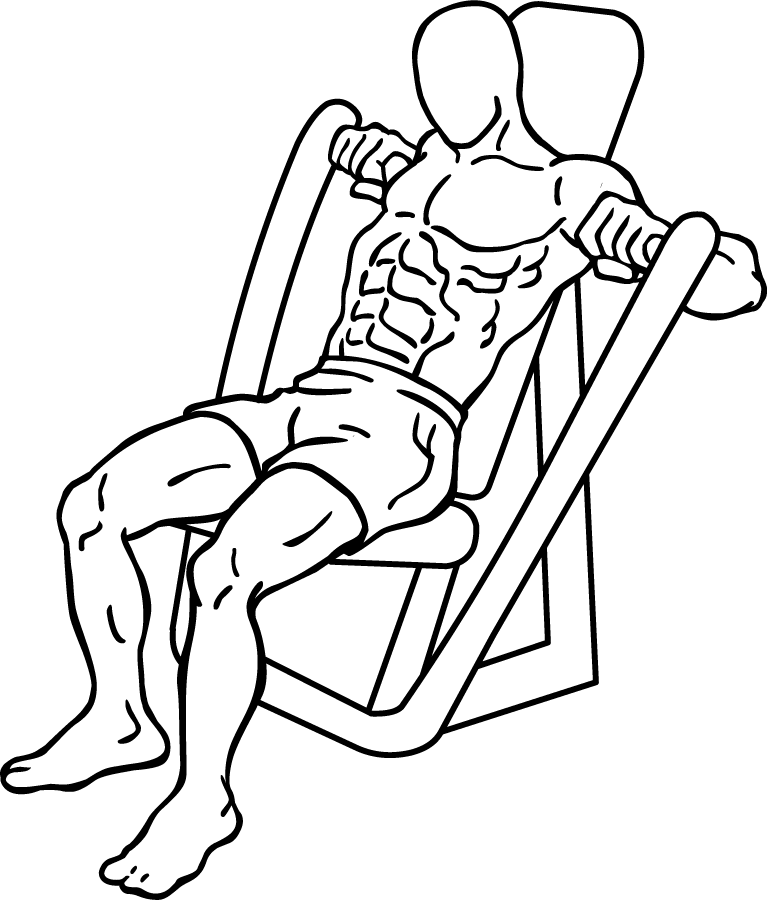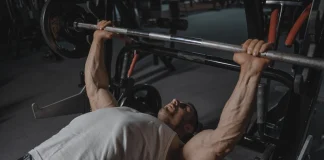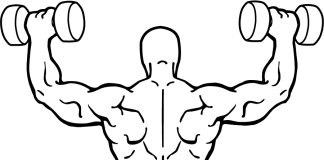Last Updated on September 26, 2014
The Machine Bench Press is a popular exercise for developing the chest, biceps, and shoulders. Unlike the traditional bench press with free weights, the machine provides stability, allowing you to focus on muscle engagement without worrying about balance. This makes it an excellent option for beginners or those recovering from injuries, as well as seasoned lifters looking to isolate their upper-body muscles more effectively.
In this comprehensive guide, we’ll break down everything you need to know about the Machine Bench Press: its benefits, step-by-step instructions, common mistakes, variations, and tips on how to incorporate it into your workout for optimal upper body strength and definition.
Why the Machine Bench Press is Effective
The Machine Bench Press is an effective exercise for targeting the pectoral muscles, as well as the shoulders and triceps, with a more controlled range of motion. This control helps reduce the risk of injury, especially for those with limited experience or mobility. Here’s why it stands out:
- Isolated Muscle Activation: By removing the need for stabilization, the machine bench press enables focused activation of the chest, shoulders, and triceps.
- Improved Muscle Endurance: The consistent motion helps build muscular endurance, which is valuable for sports and activities that require upper-body stamina.
- Supports Strength Development: With a set movement path, you can handle heavier weights safely, which is useful for strength gains.
- Great for Beginners and Rehab: The fixed path of the machine allows beginners to learn proper pressing mechanics and helps those recovering from injuries regain strength.
Muscles Targeted in the Machine Bench Press
Understanding which muscles are activated can help you appreciate the benefits of this exercise more fully:
- Chest (Pectorals): The primary target, working both the pectoralis major and minor to build size and strength.
- Triceps: The pressing motion activates the triceps, assisting in arm extension and contributing to overall arm strength.
- Shoulders (Deltoids): The anterior (front) deltoids are heavily engaged, supporting shoulder stability and contributing to overall upper body shape.
Step-by-Step Guide to Performing the Machine Bench Press
Step 1: Set Up the Machine
- Adjust the Seat: Start by adjusting the seat height so that the handles align with the middle of your chest. This positioning ensures that the chest, not the shoulders, is doing the bulk of the work.
- Check the Backrest Angle: Make sure your back is fully supported by the backrest, with a slight natural arch in your lower back for stability.
Step 2: Position Your Feet
- Use the Foot Rest: Place your feet on the foot rest, if available, or plant them flat on the floor. Stable foot positioning will help provide a strong base and prevent lower body movement during the exercise.
- Engage the Core: Tighten your core muscles to stabilize your torso and keep your back pressed against the backrest.
Step 3: Grip the Handles
- Use a Full Grip: Hold the handles with a full grip, with your thumbs wrapping around the bars for a secure hold.
- Position Your Hands: Your hands should be slightly wider than shoulder-width apart, ensuring your elbows form about a 90-degree angle at the starting position.
Step 4: Press the Weight Out
- Extend Your Arms Slowly: Press the bars forward in a controlled motion, extending your arms as far as possible without locking out your elbows. Locking out the elbows shifts stress from the muscles to the joints, which can lead to strain.
- Focus on the Chest: As you press, focus on engaging your chest muscles to push the weight rather than relying on your shoulders or triceps.
Step 5: Pause and Return to Starting Position
- Pause at the Top: Once your arms are fully extended, hold for a brief pause to maximize muscle contraction.
- Control the Return: Slowly release the weight, allowing it to return to the starting position while keeping tension on your chest. Avoid letting the weight drop suddenly, as this reduces muscle activation and increases injury risk.
Repeat the movement for the desired number of repetitions, focusing on form and control throughout each rep.
Tips for Perfecting Your Form
- Avoid Overextending: Do not lock out your elbows at the top. Keeping a slight bend ensures continuous tension on the muscles.
- Engage Your Core: A tight core supports stability and prevents arching in the lower back, reducing injury risk.
- Focus on a Steady Tempo: Avoid rushing through reps. A controlled pace maximizes time under tension, leading to better muscle engagement.
- Breathe Correctly: Exhale as you press the weight out and inhale as you bring it back. Proper breathing helps maintain rhythm and control.
Common Mistakes and How to Avoid Them
Even with machine exercises, form is key. Here are some mistakes to avoid for the Machine Bench Press:
- Incorrect Seat Height: If the seat is too high or too low, you’ll shift emphasis to the shoulders or strain the joints. Always adjust so the handles are at chest level.
- Allowing the Weight to Drop: Letting the weight return too quickly reduces muscle engagement. Control the weight on the way back to the starting position.
- Relying on the Shoulders: This exercise targets the chest. Make sure your chest is leading the motion rather than your shoulders.
- Shrugging the Shoulders: Keep your shoulders down and relaxed. Shrugging can lead to unnecessary neck and shoulder tension.
Variations of the Machine Bench Press
Adding variety to the machine bench press can help target the muscles differently and prevent plateaus. Here are some variations to try:
1. Single-Arm Machine Bench Press
Perform the exercise one arm at a time. This variation increases the demand on your core and stabilizer muscles to prevent rotation, while also allowing you to focus on each arm individually to correct any muscle imbalances.
2. Incline Machine Bench Press
Adjust the seat so that the machine’s handles are higher than chest level, mimicking the incline bench press. This targets the upper chest more directly and engages the shoulders, offering a slightly different emphasis than the traditional flat machine bench press.
3. Close-Grip Machine Bench Press
Place your hands closer together on the handles to shift focus to the triceps. This variation still works the chest but emphasizes the triceps and inner chest.
4. Reverse Grip Machine Bench Press
Using an underhand grip, push the weight forward. This variation targets the upper chest and can be less stressful on the shoulders, offering a unique angle to engage the chest muscles.
Sample Upper Body Workout Including the Machine Bench Press
Here’s a balanced upper body routine that incorporates the Machine Bench Press as a primary chest exercise:
- Warm-Up: 5-10 minutes of light cardio and dynamic stretching, focusing on the chest, shoulders, and arms.
- Machine Bench Press: 3 sets of 8-12 reps, focusing on form and control.
- Dumbbell Flyes: 3 sets of 10-12 reps to isolate the chest.
- Shoulder Press (Machine or Dumbbells): 3 sets of 8-10 reps.
- Cable Crossovers: 3 sets of 10-12 reps, emphasizing chest definition.
- Triceps Pushdown: 3 sets of 10-12 reps for triceps isolation.
- Face Pulls (Cable): 3 sets of 12-15 reps for upper back and shoulder health.
- Cool Down: Light stretching for the upper body to improve flexibility and aid recovery.
Safety Tips for the Machine Bench Press
- Choose an Appropriate Weight: Start light, especially if you’re new to this exercise, and increase the weight gradually to avoid joint strain.
- Check Machine Settings: Adjust the seat and backrest properly each time to ensure correct positioning and avoid placing stress on your shoulders or elbows.
- Use a Spotter for Heavy Sets: If lifting heavy, a spotter can help in case you fatigue mid-rep, ensuring safety.
- Listen to Your Body: If you feel any discomfort in your joints, especially the shoulders or elbows, reduce the weight and re-evaluate your form.
Progressive Overload Techniques
To see progress with the Machine Bench Press, apply progressive overload by:
- Increasing Weight Gradually: Once you can comfortably perform 12 reps, consider increasing the weight in small increments.
- Adding Reps or Sets: When consistent with your current weight, add an extra rep or set to further challenge the muscles.
- Adding a Pause: Pausing briefly at the top or bottom of each rep increases time under tension, promoting muscle growth.
- Slowing Down the Tempo: Perform each phase of the lift slowly, focusing on muscle contraction and extending time under tension.
Integrating the Machine Bench Press into Different Workouts
The Machine Bench Press is versatile and can be incorporated into various workout structures:
- Chest Day: Use it as a primary chest exercise or for targeting the chest after a heavier free-weight press.
- Push Day: Combine it with shoulder and triceps exercises for a comprehensive push workout.
- Full-Body Workout: Include it as one of the upper-body exercises in a full-body workout, focusing on moderate weight and high reps for endurance.
Tracking Your Progress
Tracking your performance over time is essential for maximizing gains with the Machine Bench Press:
- Reps and Sets: Record the number of reps and sets completed for each session. Once you’re consistently reaching your target rep range, you can increase the weight or add more sets.
- Weight Lifted: Gradually increase the weight as you build strength, but always prioritize form over heavy loads. Small increments help ensure continuous progress while minimizing the risk of injury.
- Form and Control: Note any form adjustments or improvements in control. Quality reps with a full range of motion and consistent technique lead to better muscle engagement.
- Tempo Variations: Experiment with slower tempos and track how they affect your performance. For instance, slowing down the lowering phase (eccentric motion) can enhance muscle growth and provide a new challenge.
Frequently Asked Questions (FAQs)
1. Is the Machine Bench Press as effective as the free-weight bench press?
- Both are effective, but they serve different purposes. The machine bench press offers stability, making it easier to isolate the chest without engaging stabilizer muscles as much. For overall strength and functional training, the free-weight bench press is superior. However, the machine bench press is excellent for isolating the chest and controlling form.
2. How often should I perform the Machine Bench Press?
- Performing this exercise once or twice a week is typically sufficient, especially when combined with other chest exercises. Allow 48-72 hours between sessions to give your muscles time to recover.
3. Can beginners start with the Machine Bench Press?
- Yes, the machine bench press is great for beginners. It provides stability and helps them learn proper pressing mechanics before moving on to free weights.
4. What if I feel discomfort in my shoulders during this exercise?
- Discomfort could indicate improper form or incorrect seat height. Ensure the machine is adjusted so the handles are at chest height. If discomfort persists, consult a trainer for guidance or consider alternative chest exercises.
5. Should I use a wide or narrow grip on the handles?
- A shoulder-width or slightly wider grip is ideal for chest engagement. A narrow grip shifts more emphasis to the triceps, while a wider grip can place strain on the shoulder joints. Experiment with different grips to find the most comfortable position.
Final Thoughts
The Machine Bench Press is a versatile, safe, and effective exercise for building strength and muscle in the chest, shoulders, and triceps. It’s ideal for both beginners and experienced lifters, offering the ability to focus on muscle engagement without the added challenge of balance and stability required in free-weight presses.
By following proper form, progressively increasing resistance, and integrating variations, you can continuously challenge your upper body and achieve balanced strength and definition. Make the Machine Bench Press a regular part of your workout routine to build a stronger, more sculpted upper body, and enjoy the progress as you push towards your fitness goals.








